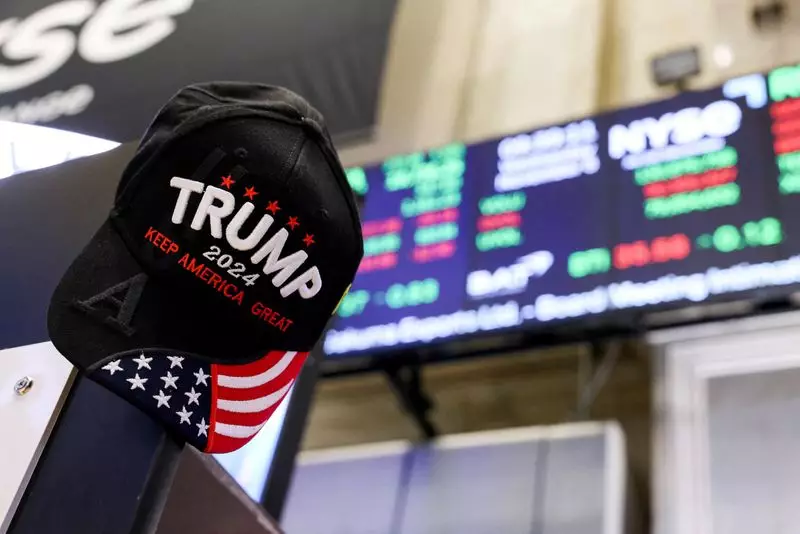On a seemingly quiet Friday morning, U.S. stock index futures exhibited muted movements, reflecting a broader sense of fragility within the market. This came on the heels of Wall Street’s impressive performance, where major indexes were positioned for their second consecutive week of gains. Yet, beneath this veneer of stability lay a tapestry woven with threads of uncertainty, particularly concerning President Donald Trump’s fluctuating trade policies. Market participants were left in limbo, grappling with the implications of potential tariffs and their reverberating effects on the economy.
The tension surrounding tariffs was palpable as Trump reiterated their importance during various public engagements throughout the week. However, his statements lacked concrete details, leaving investors to speculate on the forthcoming imposition of surcharges on U.S. trading partners. The looming announcement dates – February 1 for preliminary tariffs and April 1 for comprehensive plans after federal reviews – only intensified market apprehension. The overarching sentiment was one of caution, with investors acutely aware that tariffs could ignite a global trade war, generate inflationary pressures, and potentially delay anticipated interest rate cuts from the Federal Reserve.
Analysts remained wary as uncertainty surrounding tariff policies brewed throughout the market landscape. Mark Haefele, a prominent figure in global wealth management, offered a sobering outlook, assigning a 50% probability to an escalation of tariff rates between the U.S. and China, projecting an effective rate rise to 30%. He further warned of retaliatory measures from China, inciting fears of a destabilized trade environment. This predictive framework indicated additional efforts to safeguard U.S. technological interests and the potential for transshipment regulations that could trickle down to affect various sectors.
As market sentiment hung in the balance, futures for the Dow dipped by 98 points, representing a 0.22% decline, while the S&P 500 and Nasdaq also saw slight reductions. This tepid performance followed a significant breakout for the benchmark indices, which had recently reached record highs. The positive momentum for Wall Street can be attributed to several factors, including the encouraging discourse around artificial intelligence investments initiated by Trump, alongside decreasing inflation indicators and robust earnings from major banking institutions.
As corporate earnings reports begin to flood in, market participants are scrutinizing each announcement for insights on economic health. Notably, Boeing’s sharp decline of 1.6% served as a wakeup call, as the aerospace giant warned of a staggering $4 billion loss for the fourth quarter of the previous year. Investors braced for the company’s upcoming quarterly results, mindful that such significant losses could signal broader structural issues within the industry.
The technology sector also bore witness to mixed results, with Texas Instruments experiencing a steep drop of 3.7% following a lackluster profit forecast for the first quarter. In contrast, American Express reported a commendable 12% rise in fourth-quarter profits, yet this did not translate to positive sentiment; the stock faced a 2.6% decrease. A similar narrative unfolded with Verizon, which saw a slight dip after announcing disappointing projections for annual free cash flow and adjusted profits.
The anticipation in the market was palpable as investors looked ahead to next week, when major players such as Microsoft, Meta, Apple, and Tesla were set to unveil their quarterly results. These reports were expected to wield considerable influence over market sentiment, particularly in light of the ongoing uncertainties surrounding trade policies.
Global trade dynamics emerged as a crucial component of the prevailing economic discourse, particularly in relation to U.S.-listed shares of Chinese companies. The rally observed in stocks like JD.com, Xpeng, and Alibaba exemplified a fleeting moment of optimism, spurred by Trump’s statements hinting at a potential easing of tariff implications against China. Investors reacted positively, yet the overarching uncertainty continued to cast a shadow over the market, reflecting the inherent volatility tied to trade negotiations.
As the market wades through this uncertain terrain, the interplay between corporate earnings, trade policies, and investor sentiment will prove instrumental in shaping future trajectories. The upcoming weeks are set to be pivotal, requiring investors to remain vigilant as they navigate the complex landscape of market fluctuations and economic indicators. Whether this period of calm will yield to a more defined trajectory or dissolve into chaos largely hinges on the unfolding narrative surrounding trade policies and corporate performance.

